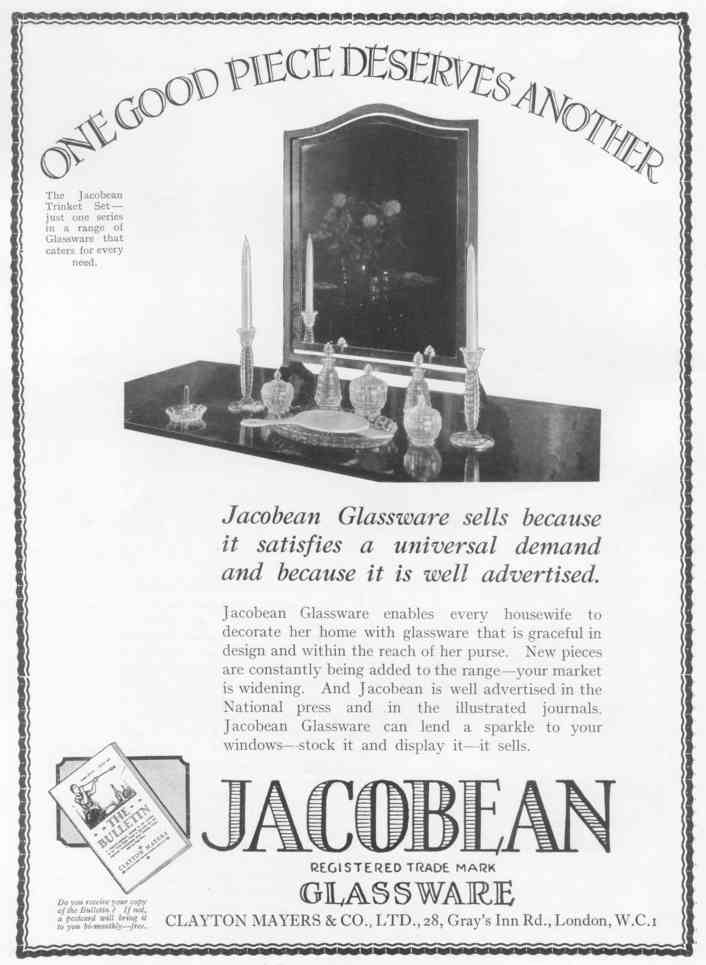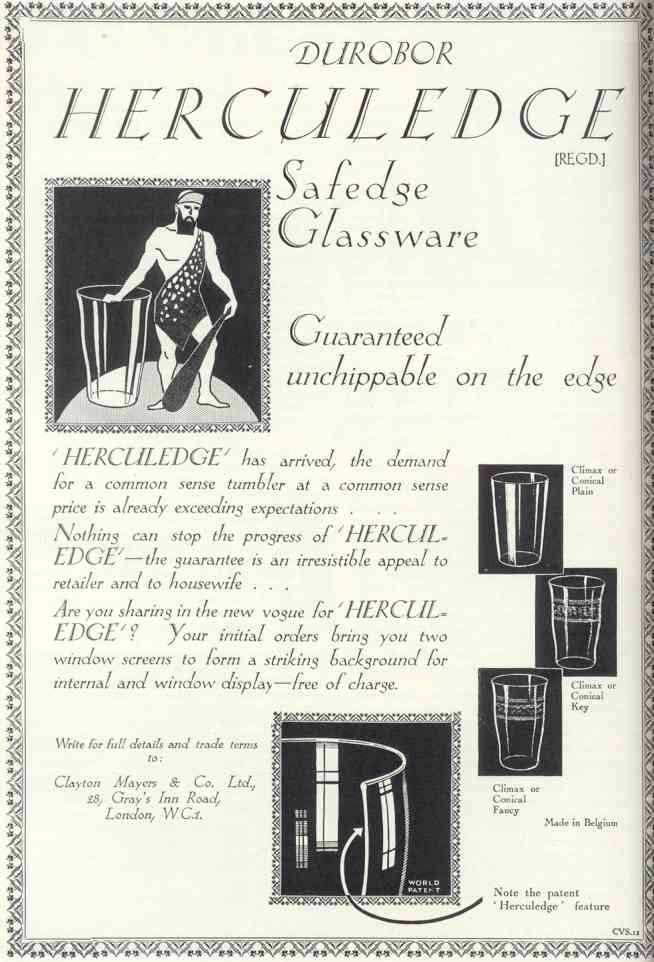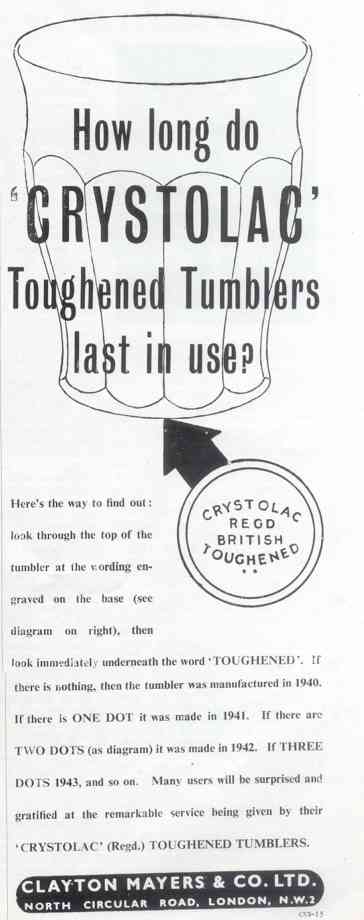|
|
|||||||||||||||||||||||
|
|||||||||||||||||||||||
If you were to ask anyone to name a suite of 20th Century glassware, then the name Jacobean would be at the top of the list. The distinctive style of Jacobean glassware made it a favourite from 1923, when it was first introduced, right up until the 1960s and beyond. There is probably more Jacobean glassware around than any other style of pressed glass. Jacobean was made in Czechoslovakia by Josef Inwald A.G. and imported into the UK by the remarkable company of Clayton Mayers & Co. Ltd.
 The
firm of Clayton Mayers was founded in 1860 By James Clayton Mayers in the
Somerset town of The Devizes. James, or J.C. as he was called, took over a
shop and from that small beginning came the Clayton Mayers company .
Throughout its long life it has always been a family firm with second and
even third generation Mayers taking an active part in the running of the
company and in designing its products. Whilst it is best known for Jacobean
glassware, the firm was essentially a wholesale supplier of both glassware
and pottery to shops all around the country. The
firm of Clayton Mayers was founded in 1860 By James Clayton Mayers in the
Somerset town of The Devizes. James, or J.C. as he was called, took over a
shop and from that small beginning came the Clayton Mayers company .
Throughout its long life it has always been a family firm with second and
even third generation Mayers taking an active part in the running of the
company and in designing its products. Whilst it is best known for Jacobean
glassware, the firm was essentially a wholesale supplier of both glassware
and pottery to shops all around the country. Towards the end of the 19th Century, James moved the company to London and set up offices in Grays Inn Road. James would be seen travelling around London in a horse drawn Chaise with his samples in basket panniers. Some of his largest supplies at that time included Davidson, Moor and Baccarat. Advertising was always seen by James as an important part of doing business. Clayton Mayers advertised heavily in trade journals such as the Pottery Gazette, as well as in consumer journals such as Ideal Homes, Punch and later the TV Times. In the 1950s they were the first glass company to advertise on the new medium of television. Heavy advertising and promotion were a key factor in the success of Jacobean. Indeed in 1929 they were offering a free window display to their customers. By 1923, when Clayton Mayers first introduced Jacobean glassware, they were selling a wide range of glassware from the UK, Czechoslovakia Norway and Belgium. As well as suites of table glassware they were selling tumblers, wines, caraffes, flower tubes and cut lead crystal glassware. The 'Dazzlex' range of cut crystal glassware included over 70 different articles and was still being sold in the 1960s. In 1923 they introduced the Jacobean range and in December of that year Clayton Mayers registered the first of the Jacobean registered designs (17th December 1923 No 702446). Over the next three years, Clayton Mayers registered no fewer than 18 new designs, although not all were for Jacobean glassware. |
Jacobean was an instant success, and within a few years of its introduction there were 150 different items in the range. This had increased to 275 by the start of the war, although most items in the range are extremely rare today. Produced mainly in flint glass, Jacobean can also be found in colours such as Blue, Green, Amber and in rare instances Marigold Carnival glass (for an article on Carnival Jacobean visit Glen and Steve Thistlewood's carnival web site at http://www.geocities.com/carni_glass_uk_2000/Jacob2.html.
 Jacobean
was not the only glassware Clayton Mayers sold in the 1920s. Other ranges
included Coronet - a pressed glass design introduced in 1928, Dazzlex,
Sheraton, Vine and Ganymede. Many of these ranges were hand-cut lead
crystal. Dazzlex was still being made in the 1960s. In 1930 they introduced
a new line Durobor Herculedge 'Safedge Glassware'. The tumblers and like in
this range were 'Guaranteed unchippable on the edge'. A later advert was to
have the tag line 'If you chip it, you change it!'. The Herculedge name was
trademarked and protected by patents. Herculdege was imported from Belgium. Jacobean
was not the only glassware Clayton Mayers sold in the 1920s. Other ranges
included Coronet - a pressed glass design introduced in 1928, Dazzlex,
Sheraton, Vine and Ganymede. Many of these ranges were hand-cut lead
crystal. Dazzlex was still being made in the 1960s. In 1930 they introduced
a new line Durobor Herculedge 'Safedge Glassware'. The tumblers and like in
this range were 'Guaranteed unchippable on the edge'. A later advert was to
have the tag line 'If you chip it, you change it!'. The Herculedge name was
trademarked and protected by patents. Herculdege was imported from Belgium.
In 1931 Clayton Mayers moved their offices to Cricklewood on the North Circular road, London. They also opened a new showroom in a new building at No. 44 Holborn Gardens, London. The showroom was only 300 yards from Holborn Circus which was the heart of the Pottery and Glassware London showrooms. An article in the Pottery Gazette gave a glowing account of the showroom saying
The design of the showroom, complete with a rest room, was designed to attract the dealers. The idea of producing an advertising film for the cinema showed their strong belief in good advertising. The film was made and was shown in 550 cinemas in October 1931. The film, entitled 'Address Parade', included 'A visit to Miss Madeleine Carroll's Flat' a scene which demonstrated the beauty & utility of Jacobean glassware. Miss Madeleine Carroll was the Jacobean hostess for 1931 |
Around this time Eric Mayers,
younger son of James, patented a method of packing mixed quantities of glassware
under pressure into cardboard boxes. This method which was still in use as late
as 1960.
The price of imported glassware became more
expensive in late 1931. Firstly Britain came off the gold standard and as a
result to value of the pound fell. A falling pound made imports more expensive
and exports cheaper. The falling price caused some imports to rise as much as
28%. Then in November 1931 an anti-dumping order was
issued under the 'Abnormal Importation (Custom Duties) Act' of 1931. As from
November 25th of 1931, all imports of pottery and glass were subject to a 50%
duty. As Jacobean was a low price product, Clayton Mayers could not afford to
raise prices too much. So they turned to Davidson to make Jacobean in the UK. In
the early months of 1932 they were forced to raise the price of Jacobean
slightly, but then in May they proudly announced that Jacobean Tumblers were now
British made. They were able to reverse the price rise and very quickly they
announced that Jacobean jugs were also British made. The Jacobean range was now
being made by Davidson, and soon all of the Jacobean range, and other Clayton
Mayers glassware ranges were being made by Davidson. Clayton Mayers made the
fact of the British origin a selling point and this featured prominently in
their advertising for the rest of 1932. The contract was very lucrative for
Davidson and led to further orders in later years.
( The antidumping order was short lived and on April 1st 1932 new tariffs came into force and the order was revoked. Imported domestic glassware now had a lower 20% tariff. This angered the UK glassware industry. )
 Part of the success of Jacobean was its low price and high quality. Clayton Mayers were always looking for ways to keep the price down and at the start of the war they turned to making machine-made Jacobean glassware. The switch to machine-made Jacobean meant that there had to be some small changes to the design. A side effect was that the machine made glassware was lighter and, they said, of a higher quality than the hand pressed kind. With the move to machine made glassware, The amount of pressed glass Davidson made for Clayton Mayers fell, but this was more than offset by the introduction of Toughened Tumblers. In 1940 Clayton Mayers introduced the 'Crystolac'
Toughened Tumblers. Theses were made by Davidson and proved to be vital in
helping Davidson survive the war and the turmoil in the years that followed.
In 1942 Toughened Tumblers produced a £14,000 increase in revenue for
Davidson. Towards the end of the 1940s, 17% of Davidson's turnover came from
Clayton Mayers, nearly 14% from Toughened Tumblers alone. Davidson were to
continue to make tumblers for Clayton Mayers up until the 1960s.
|
 In 1962 big changes occurred at
Clayton Mayers. H. G. Mayers retired as chairman at the age of 76. Johnsen &
Jorgensen, another wholesale supplier of glass (founded 1906), bought a
substantial stake in Clayton Mayers. Johnsen & Jorgensen sold a wide range of
glassware including Sherdley. It the early years of the century they were best
known for making jars and decanters; some of their designs were registered.
In 1962 big changes occurred at
Clayton Mayers. H. G. Mayers retired as chairman at the age of 76. Johnsen &
Jorgensen, another wholesale supplier of glass (founded 1906), bought a
substantial stake in Clayton Mayers. Johnsen & Jorgensen sold a wide range of
glassware including Sherdley. It the early years of the century they were best
known for making jars and decanters; some of their designs were registered.
The company announced that it was to expand
into the new field of high quality decoration of domestic glassware and
appointed R.K Symmons as Marketing Directory. Symmons came from Black & Decker
and immediately introduced changes in the way the company used sales statistics
to forecast future marketing requirements. He was also responsible for
introducing a new series of consumer leaflets designed to push the companies
products. Changes in packaging were also introduced to enhance the company name.
For example instead of loose orders being packed in wood-wool and straw, they
were packed in cartons of standard design the Clayton Mayers and product name.
New machinery was purchased to partially
automate the glass cutting and polishing process. These machines, imported from
America, were first used in the new Monarch range of cut calcium crystal
sherries and goblets. The Monarch range was cut and acid polished and
embellished with unpolished stars. Calcium crystal could be sold at 1/3 of the
cost of conventional lead crystal. New lehrs were also introduced to improve the
enamelling process of decorating glass. Over the next few years new designs such
as Wessex, Colour Craft, Madison, Ganymede, English Rose (based on Victoria and
Albert Museum designs) and "Age of Chivalry" (design based on Medieval knights
in armour) were introduced. The bright colourful designs reflected the style of
the 1960s.
After the mid 1960s, the name of Clayton
Mayers fades from view. The Johnsen & Jorgensen company are still in business
today, but what happened to Clayton Mayers? We are still researching their later
history.
Clayton Mayers Registered Designs
The following table lists the Clayton Mayers registered designs up to 1940.
| Design Number | Date | Design Number | Date |
|
553476 |
1 December 1909 |
716035 |
16 September 1925 |
|
680571 |
24 January 1921 |
719077 |
16 February 1926 |
|
702446 |
17 December 1933 |
719644 |
16 September 1925 |
|
705632 |
15 May 1924 |
721365 |
27 May 1926 |
|
707091 |
19 July 1924 |
723615 |
31 August 1926 |
|
707762 - 707763 |
1 September 1924 |
735621 |
15 February 1928 |
|
709052 - 709054 |
7 November 1924 |
750112 |
15 November 1929 |
|
709314 |
21 November 1924 |
791409 |
22 March 1934 |
|
710214 - 710216 |
5 January 1924 |
810370 |
29 February 1936 |
|
711883 |
21 March 1925 |
|
|
|
|